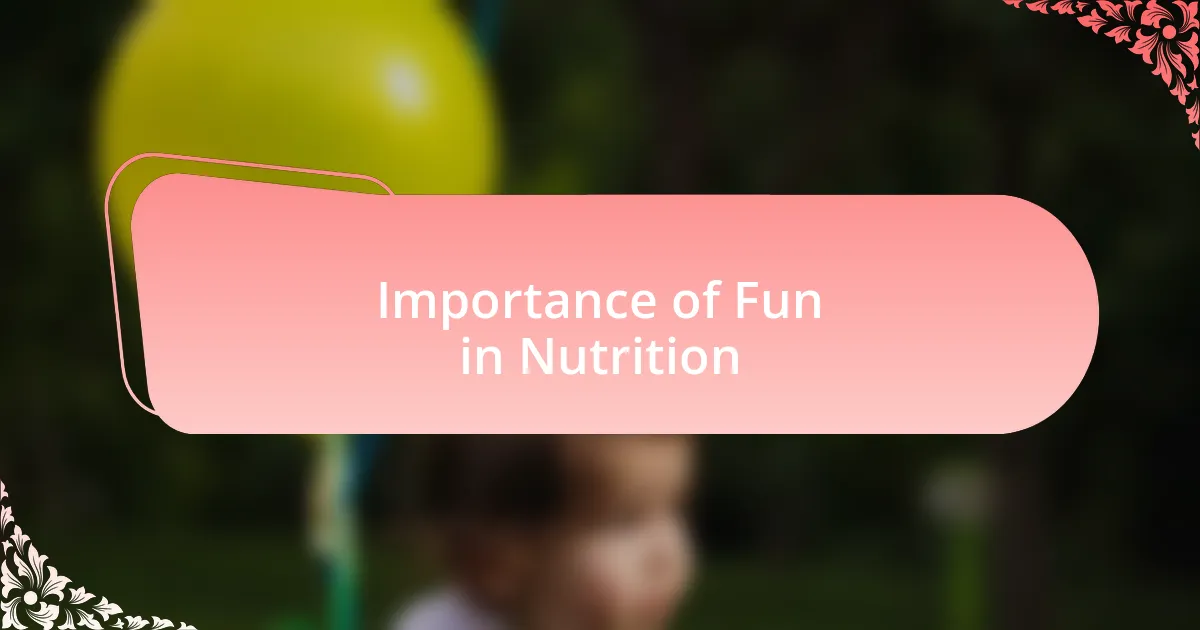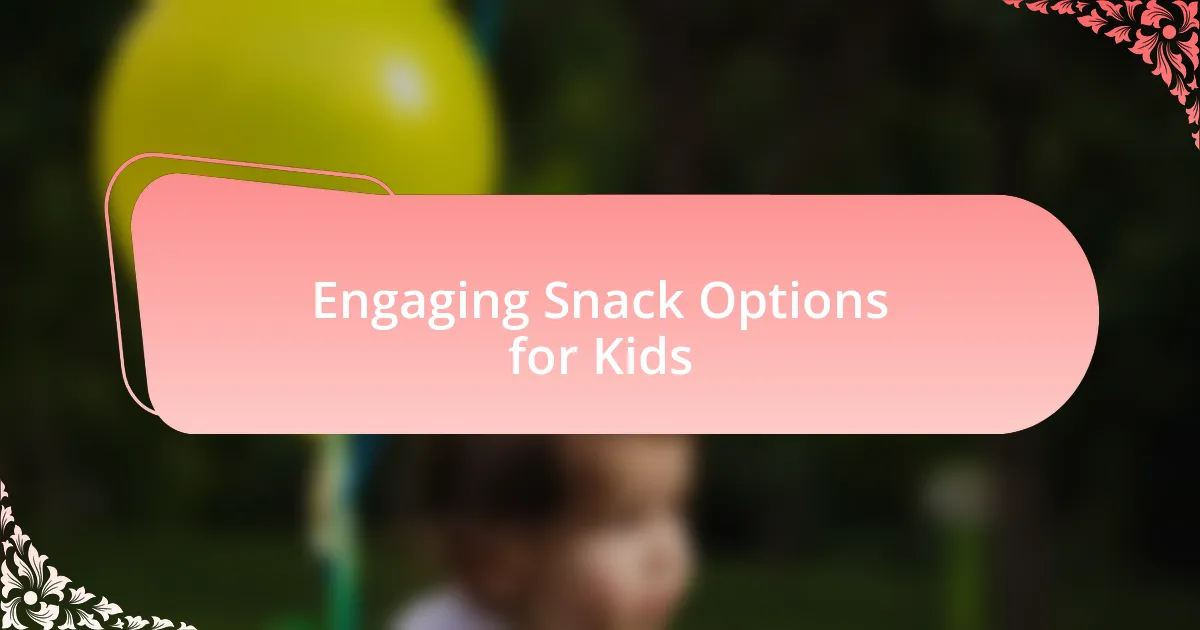Key takeaways:
- Introducing a variety of flavors and textures early on helps children develop healthy eating habits and a positive relationship with food.
- Engaging children in meal preparation can create lasting memories and deepen their connection to food.
- Making nutrition fun through themed meals and creative cooking activities empowers children to explore healthy options and express their tastes.
- Hands-on experiences, like growing herbs or making snacks, cultivate a deeper respect for food and foster creativity in kids.

Understanding Child Nutrition Principles
Understanding child nutrition principles is essential for fostering healthy eating habits from a young age. I remember a time when my son was reluctant to try new foods. It struck me then how important it is to introduce a variety of flavors and textures early on, so children develop a palate that welcomes diverse foods.
Nutrition isn’t just about filling stomachs; it’s about fueling growing bodies and minds. I often think back to my daughter’s first experience with gardening. Watching her excitement as she picked fresh tomatoes made her more eager to eat them, proving that sometimes, the experience of food can spark a child’s interest more than just telling them what’s healthy.
It’s crucial to not only focus on what kids eat but also how they eat. Do you involve them in meal prep? When I used to have my kids help chop vegetables or mix ingredients, it wasn’t just about getting a meal on the table. It was a way to create memories, deepen their connection with food, and instill lifelong skills that they would carry with them.

Importance of Fun in Nutrition
Making nutrition fun is paramount, especially for children. I recall a family cooking night where we turned healthy eating into a game. We challenged each other to create the most colorful plate, and suddenly, my kids were more interested in eating vegetables than ever before. Isn’t it remarkable how a little creativity transforms food from mundane to exciting?
Exploring playful food themes can ignite a child’s curiosity. Once, I made a “food art” day, where we crafted funny faces out of fruits and veggies. My daughter giggled as she arranged sliced cucumbers as eyes and strawberries for a smile. These playful experiences can help children not only eat better but also develop positive associations with healthy foods.
When meals become a joyful event, children are more likely to embrace new flavors. During our regular potluck-style dinners with friends, I noticed how my son was thrilled to discover he loved quinoa after a friend brought a colorful quinoa salad. It was a shared experience filled with laughter and discovery, proving that the joy in eating can lead to healthier choices. Don’t you think these joyful moments in food can lay the groundwork for better nutrition habits?

Creative Meal Planning Ideas
Creative meal planning can be an adventure for both kids and parents alike. I vividly remember the time we decided to theme our dinners around different countries. One week, we “visited” Italy with homemade pizzas, letting the kids top their creations with fresh vegetables. Watching them explore the flavors of each country was not just entertaining; it also sparked curiosity about cultural cuisines. What a joy it is to see them embrace not just the food, but the stories behind it!
Incorporating fun challenges can elevate meal planning to a new level! I once introduced a “mystery ingredient” night where my kids had to select a secret item from our pantry to use in their dishes. They loved the thrill of surprise and, surprisingly, my son mixed spinach into a smoothie without hesitation! Have you ever witnessed such excitement where kids become little chefs? Moments like these encourage them to experiment and develop their culinary skills while enjoying healthy options.
Another idea that has brought my family together is creating a “build-your-own” night, whether it’s tacos, salads, or even pasta. I still recall the buzzing energy around our table as everyone chose their toppings and assembled their dishes. Not only did this empower my children to take charge of their meals, but it also fueled lively discussions about their choices. How empowering does it feel when kids take ownership of their food and learn to balance flavors and nutrition?

Engaging Snack Options for Kids
I discovered that snacks can also double as a fun activity! One afternoon, we spent time making colorful fruit kebabs. The kids loved selecting which fruits to add and arranging them on skewers. It turned snack time into a whimsical art project where every bite was not just tasty, but vibrant too. Have you ever seen a child beam with pride over their self-made treat?
Another engaging option I tried was veggie-faced sandwiches. I would spread cream cheese on whole-grain bread and let the kids create funny faces using sliced cucumbers, cherry tomatoes, and olives. Watching them craft whimsical designs made eating their veggies a delightful game. Isn’t it amazing how a touch of creativity can turn a simple snack into a source of joy and excitement?
One of my favorite memories was hosting a “snack party” where kids created their own trail mix. I laid out bowls filled with nuts, seeds, dried fruits, and a sprinkle of chocolate chips. Each child dove into their choices, mixing flavors to create their personalized snack masterpiece. The chatter, laughter, and shared excitement were priceless, proving that snacks can not only nourish but also foster connection and creativity. How often do we overlook the potential of food to be a source of fun?

Utilizing Interactive Cooking Activities
I’ve found that interactive cooking activities can transform the kitchen into a playground of creativity. One weekend, we decided to make homemade pizza from scratch. I let the kids stretch and shape their own dough, which turned into a contest of who could create the most outrageous pizza shape. Their giggles and enthusiasm as they piled on toppings made me realize how cooking together helps build confidence and cooperation.
Another memorable cooking experience was when we prepared our own taco night. I set up a taco bar with all sorts of fillings: seasoned meat, vibrant veggies, and tangy salsas. As the kids piled their plates with their favorite ingredients, I couldn’t help but smile—this was more than just dinner; it was a chance for them to express their tastes and preferences. Have you ever witnessed such joy in self-expression over food?
I also remember our baking day when we made healthy oatmeal cookies. The children took turns adding ingredients like mashed bananas and dark chocolate chips. It was heartwarming to see them strategize together about what flavors would work best. The look of anticipation as the cookies baked filled the kitchen with warmth, and those little moments made me ponder: how often do we allow kids to actively shape their food experiences?

Personal Experiences with Nutrition
Working with my kids in the kitchen has consistently been eye-opening. I recall one afternoon when we explored different fruits for smoothies. Each of my children eagerly picked their favorites, and we ended up with a rainbow of flavors. Watching their faces light up during the taste test made me realize how empowering it is for them to make enthusiastic choices about what they eat.
Additionally, I had a particularly rewarding experience during a “healthy snack challenge.” I assigned each child a nutritional goal—one focused on protein, another on fiber. They came up with inventive ideas like yogurt parfaits and veggie platters decorated with funny faces. I still remember the pride in their voices as they presented their creations to the family. Isn’t it fascinating how much ownership they felt just by taking an active role in the choice and preparation process?
Another moment that stands out occurred when we tried our hand at growing herbs together. I set up a small windowsill garden, and the kids eagerly helped plant basil and parsley. As we used those fresh herbs in our meals, the connection between growing and eating became clearer to them. Isn’t it incredible how such simple activities can cultivate a deeper respect for food and nutrition?